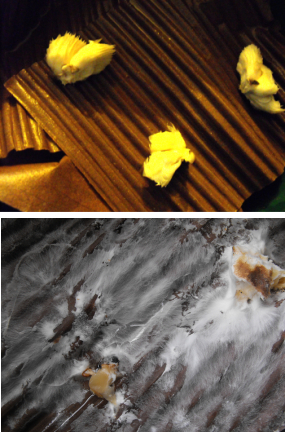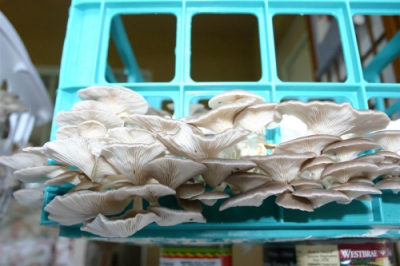
Can growing mushrooms be as easy as a worm bin?
 Next
week, I'll continue my summary of the techniques Paul Stamets uses to
cultivate mushrooms in a commercial setting. But I wanted to take
a break and talk about my own experiment. If you haven't already,
you can read how I
sandwiched oyster mushroom stem butts
between layers of wet cardboard in a flower pot --- this is the cloning
stage of the operation. After a week, I saw mycelium
running across the cardboard, so I expanded
it by putting the mycelium between more layers of wet cardboard in a
bigger container.
Next
week, I'll continue my summary of the techniques Paul Stamets uses to
cultivate mushrooms in a commercial setting. But I wanted to take
a break and talk about my own experiment. If you haven't already,
you can read how I
sandwiched oyster mushroom stem butts
between layers of wet cardboard in a flower pot --- this is the cloning
stage of the operation. After a week, I saw mycelium
running across the cardboard, so I expanded
it by putting the mycelium between more layers of wet cardboard in a
bigger container.
And then I messed
up. The electricity went out and the trailer's interior
temperature dropped pretty low --- nearly to freezing on the floor
furthest from the wood stove where I happened to have my spawn.
When I checked on it, my mycelium was just sitting there and some of it
had died back. Drat! I'm hoping that the cold temperatures
just put my fungi into temporary hibernation, so I've moved them to a
warmer location and will report back in a few weeks. If I don't
see growth by then, I'll go back to the beginning with new mushrooms in
the spring.
 My dream is to develop a
relatively simple method of propagating oyster mushrooms on the home
scale, without petri dishes, autoclaves, or even storebought
grain. Wouldn't it be great if mushroom-keeping was as easy as
building a worm bin and if those mushrooms could be fed with your junk
mail and cardboard, turning waste into food and garden soil? In
case you think I'm living in an ivory tower, check
out this website where the author turned cardboard and junk mail into
mushrooms --- it is
possible! I just need to work a few kinks out of my system.
My dream is to develop a
relatively simple method of propagating oyster mushrooms on the home
scale, without petri dishes, autoclaves, or even storebought
grain. Wouldn't it be great if mushroom-keeping was as easy as
building a worm bin and if those mushrooms could be fed with your junk
mail and cardboard, turning waste into food and garden soil? In
case you think I'm living in an ivory tower, check
out this website where the author turned cardboard and junk mail into
mushrooms --- it is
possible! I just need to work a few kinks out of my system.
This post is part of our Growing Gourmet Mushrooms lunchtime series.
Read all of the entries:
|
Want more in-depth information? Browse through our books.
Or explore more posts by date or by subject.
About us: Anna Hess and Mark Hamilton spent over a decade living self-sufficiently in the mountains of Virginia before moving north to start over from scratch in the foothills of Ohio. They've experimented with permaculture, no-till gardening, trailersteading, home-based microbusinesses and much more, writing about their adventures in both blogs and books.
Want to be notified when new comments are posted on this page? Click on the RSS button after you add a comment to subscribe to the comment feed, or simply check the box beside "email replies to me" while writing your comment.
- Remove comment
- Remove comment
